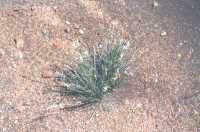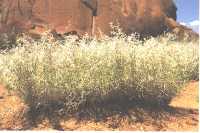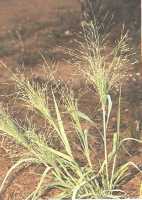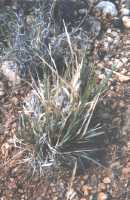
Wangunu - Naked Woollybutt
Wangunu
or Naked Woollybutt (Eragrostis
eriopoda)is an erect perennial grass that grows in dense tufts to 35
centimetres. It is widespread and common in the arid zone. It is course and wiry, and has
distinctive white "woolly butts" at the base of the plant. Wangunu
is long lived, with each plant living up to 20 years. Seeding of Naked
Woollybutt occurs after summer rain, with the seeds remaining on the plant for one
or two months.
The seed from this plant is an important
traditional staple food for the Antakarinja people. The small reddish seeds can be easily
collected by rubbing the seeds heads to remove it. It is first winnowed, then ground to a
flour and damper made. This meal is very nutritious and keeps for a long time.

Wangunu - Naked Woollybutt
photo Tim Low
Kaltu-Kaltu
Panicum decompositum
Native Millet

Kaltu-Kaltu - Native Millet
photo Tim Low
Kaltu-Kaltu or Native Millet (Panicum decompositum) is another grass used
in the same way. This plant is short-lived and is encouraged by fire. It has the same
nutritive value as Wangunu.

Kultu-Kultu - Native Millet
|